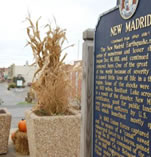 According to current scientific understanding, the New Madrid
Seismic Zone is capable of producing damaging earthquakes at any time. The earthquakes of 1811-12 were estimated to
be between a M7.0-8.0 and occurred in an area that was sparsely populated. Were these earthquakes to occur today, their
effects would be considered catastrophic, directly affecting several million people
across eight states and indirectly affecting millions of others. In an effort to prepare for this, the Federal Emergency
Management Agency (FEMA) provided funding to CUSEC to lead an effort to
develop, improve, and integrate the earthquake response plans of the eight
states in the region—Alabama, Arkansas, Illinois, Indiana, Kentucky,
Mississippi, Missouri, and Tennessee—that would be most affected by an
earthquake.
According to current scientific understanding, the New Madrid
Seismic Zone is capable of producing damaging earthquakes at any time. The earthquakes of 1811-12 were estimated to
be between a M7.0-8.0 and occurred in an area that was sparsely populated. Were these earthquakes to occur today, their
effects would be considered catastrophic, directly affecting several million people
across eight states and indirectly affecting millions of others. In an effort to prepare for this, the Federal Emergency
Management Agency (FEMA) provided funding to CUSEC to lead an effort to
develop, improve, and integrate the earthquake response plans of the eight
states in the region—Alabama, Arkansas, Illinois, Indiana, Kentucky,
Mississippi, Missouri, and Tennessee—that would be most affected by an
earthquake.
Officially started in 2006, the New Madrid Seismic Zone (NMSZ) Catastrophic Planning Project, remains the largest multi-state response planning effort of its kind, and drew upon lessons learned from previous planning initiatives throughout the nation. The effort also helped establish and refine portions of the National Response Framework, an all-hazards guide that establishes how the Nation will respond to small and large scale disasters. The priorities for project were set by CUSEC’s Board of Directors, which is comprised of the state emergency management directors from the eight CUSEC Member states. As state directors, the CUSEC Board is in a unique position to know exactly what is needed to prepare the region for a catastrophic event such as an earthquake. CUSEC is a peer-based organization where planning and response choices in the key areas of strategy, tactics, and operations are made by councils of peers drawn from every level and function for discussion and sharing of best practices.